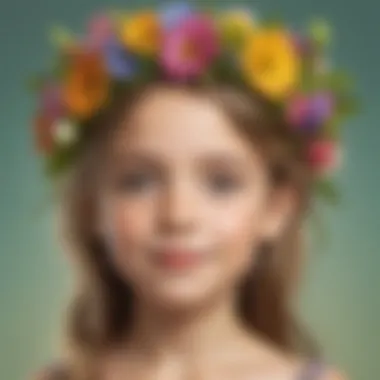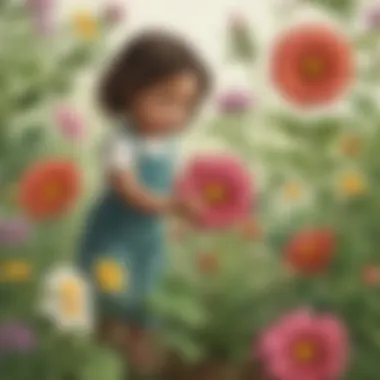Unlocking the Wonders of Flower Exploration for Preschoolers


Science Fun Facts
The vast world of flowers is not just visually stunning but also scientifically fascinating. Did you know that some flowers have adaptations like brightly colored petals to attract pollinators such as bees and butterflies? Additionally, flowers come in a myriad of shapes and sizes, each serving a specific purpose in nature's intricate web. Exploring these unique characteristics can ignite young minds and cultivate a sense of wonder and curiosity about the natural world.
Discover the Wonders of Science
Veering into the realm of botany opens up a treasure trove of scientific concepts waiting to be unearthed. From the process of photosynthesis, where flowers create their own food using sunlight, water, and carbon dioxide, to the life cycle of plants which includes germination, growth, reproduction, and eventually wilting, there is no shortage of marvels to explore. Encouraging preschoolers to delve into these scientific marvels fosters a deep appreciation for the beauty and complexity of nature.
Educational Videos and Animations
For a visually stimulating learning experience, educational videos and animations can provide dynamic insights into the life of flowers. By showcasing the growth stages of different flowers, the role of pollinators, and the importance of maintaining a healthy ecosystem, these resources can make scientific concepts come alive in a captivating way.
Real-Life Applications of Science
Understanding the science behind flowers extends beyond theoretical knowledge. It allows preschoolers to grasp the practical implications of botanical principles in everyday life. By observing how flowers contribute to the environment by producing oxygen, enhancing biodiversity, and serving as a food source for various organisms, young learners can connect scientific concepts to real-world scenarios.
Science Quiz Time
Engaging young minds through interactive quizzes is a delightful way to reinforce learning and test comprehension. By incorporating questions about flower anatomy, pollination processes, and the role of seeds in plant reproduction, preschoolers can have fun while solidifying their understanding of botanical concepts.
Multiple Choice Questions
Multiple choice questions offer a structured approach to evaluating knowledge retention. By presenting a range of answer options related to flower-related topics, children can exercise critical thinking skills and enhance their ability to make informed decisions based on the information provided.
Learning Through Gamification
Gamification techniques, such as turning quizzes into games or challenges, add an element of excitement to the learning process. By incorporating rewards or points systems for correct answers, preschoolers can feel motivated and engaged while expanding their scientific knowledge in a playful and enjoyable manner.
Science Experiment Showcase
Hands-on experiments are a cornerstone of experiential learning, allowing children to see scientific principles in action. By conducting fun and engaging experiments with flowers, preschoolers can gain a deeper understanding of botanical concepts and develop valuable skills such as observation, prediction, and analysis.
Step-by-Step Instructions
Providing clear and concise instructions for each experiment is crucial to ensure its success. From dissecting a flower to observe its different parts to creating a DIY plant growing kit, detailed step-by-step guidance can help children navigate through the process with confidence and enthusiasm.


Materials List
A comprehensive list of materials required for each experiment is essential for smooth execution. Items such as magnifying glasses, watercolor paints for flower art projects, and gardening tools for planting activities ensure that preschoolers have everything they need to actively participate and learn through hands-on experience.
Safety Tips and Precautions
Ensuring the safety of young learners during science experiments is paramount. By teaching children basic safety guidelines such as wearing gloves when handling certain plants, avoiding ingestion of plant parts, and washing hands after gardening activities, parents and educators can create a secure environment for exploring the wonders of science.
Synthesizing the information presented throughout, it is evident that immersing preschoolers in a flower-themed educational exploration offers a wealth of benefits. By integrating science fun facts, interactive learning tools, engaging quizzes, and hands-on experiments, children can embark on a captivating journey of discovery and learning, fostering a lifelong love for science and nature.
Introduction to Flower Theme
The exploration of the Flower Theme for Preschoolers holds significant importance in the realm of early childhood education. This introductory section serves as a gateway to a world of educational benefits and engaging activities for young learners. By immersing preschoolers in the enchanting realm of flowers, educators and caregivers can significantly enhance children's learning experiences. The Flower Theme not only captures the imagination of these young minds but also provides a holistic approach to early development. Through this section, we delve into the various ways in which the Flower Theme can inspire and enrich the lives of preschoolers.
Benefits of Flower Theme in Preschool Education
Enhancing Sensory Development
The integration of a Flower Theme in preschool education plays a pivotal role in enhancing sensory development. Through tactile exploration of different textures, colors, and scents of flowers, children engage their senses on multiple levels. This hands-on approach not only stimulates sensory receptors but also promotes cognitive growth. The rich sensory experience offered by flowers aids in refining fine motor skills and sensory processing abilities in young learners, laying a solid foundation for their overall development.
Encouraging Curiosity and Exploration
Encouraging curiosity and exploration through the Flower Theme fosters a sense of wonder and inquisitiveness in preschoolers. By observing the intricate details of flowers, children naturally develop a sense of curiosity about the natural world around them. This curiosity drives exploration, prompting young minds to ask questions, seek answers, and make discoveries. Through the Flower Theme, children are encouraged to engage with nature actively, nurturing their innate sense of wonder and encouraging a lifelong love for learning.
Fostering Creativity and Imagination
The Flower Theme serves as a powerful catalyst for fostering creativity and imagination in preschool education. By incorporating flowers into art, storytelling, and imaginative play, educators ignite the creative spark within young children. Flowers provide a versatile and colorful canvas for artistic expression, allowing children to explore their creative potential. Moreover, the inherent beauty of flowers stimulates the imagination, inspiring young minds to envision new possibilities and scenarios. Through the Flower Theme, children can unleash their creativity and express themselves in innovative ways.
Integration of Flower Theme in Preschool Curriculum
Science and Nature Exploration
Integrating the Flower Theme into the preschool curriculum offers unique opportunities for science and nature exploration. By studying the life cycle of flowers, identifying different plant species, and understanding pollination processes, children develop a deeper appreciation for the natural world. The Flower Theme provides a hands-on approach to learning about botany and ecology, bridging the gap between theoretical knowledge and practical experience.
Art and Craft Activities
Incorporating the Flower Theme in art and craft activities allows preschoolers to unleash their creativity and artistic talents. By engaging in flower-themed crafts such as pressed flower collages, flower printing, and DIY floral crowns, children not only enhance their fine motor skills but also express themselves artistically. This integration of art and nature instills a sense of aesthetic appreciation and creativity in young learners, fostering a love for artistic expression from an early age.


Language and Literacy Development
The Flower Theme presents a unique opportunity to promote language and literacy development in preschoolers. Through flower-themed storytelling, vocabulary building exercises, and read-aloud sessions focusing on floral imagery, children expand their communication skills and enrich their linguistic abilities. By immersing children in a world of floral language and literature, educators facilitate language acquisition and encourage a love for reading and storytelling.
Engagement and Learning Through Flowers
Hands-On Flower Experiments
Engaging preschoolers in hands-on flower experiments opens up a world of scientific exploration and discovery. By conducting experiments such as dissecting flowers, observing pollen grains, and exploring floral anatomy, children develop a keen interest in biology and botany. These hands-on activities not only spark curiosity but also foster a deep connection with the natural world, nurturing a sense of scientific inquiry in young learners.
Interactive Flower Games
Interactive flower games offer a playful yet educational way to engage children with the Flower Theme. By incorporating games that involve flower identification, matching petals, and exploring floral patterns, educators make learning fun and interactive. These games not only reinforce cognitive skills such as memory and attention but also enhance children's knowledge of flowers in an engaging manner.
Outdoor Flower Scavenger Hunts
Outdoor flower scavenger hunts provide a dynamic and immersive way for preschoolers to connect with nature and learn about different flower species. By embarking on scavenger hunts to find specific flowers, children develop observational skills, teamwork, and a deeper appreciation for biodiversity. These outdoor activities not only promote physical activity and sensory exploration but also instill a sense of environmental stewardship in young minds.
Creative Activities with Flowers
In the realm of preschool education, engaging children with creative activities utilizing flowers holds significant educational value. The intricate beauty and versatility of flowers offer a myriad of possibilities for innovative learning experiences. These activities not only stimulate the children's senses but also nurture their creativity and imagination, essential aspects of early childhood development. Through hands-on engagement with flowers, preschoolers can explore textures, colors, and shapes, fostering a deeper understanding of the natural world around them. Moreover, incorporating flower-themed activities into the curriculum can spark curiosity and enthusiasm for learning, making education a truly captivating journey.
Pressed Flower Collages
Pressed flower collages serve as a superb way to introduce preschoolers to artistic expression while connecting them with nature. By carefully selecting and pressing different varieties of flowers, children can create visually stunning collages that showcase biodiversity and encourage appreciation for botanical diversity. The intricate patterns and vibrant colors of pressed flowers lend a unique touch to artworks, allowing young learners to develop their aesthetic sensibilities. This activity promotes fine motor skills, patience, and attention to detail among children, fostering a sense of accomplishment and pride in their creations. While pressed flower collages offer an avenue for creativity, they also instill a sense of connection to nature, instigating a deeper ecological awareness and respect for the environment.
Flower Printing
The art of flower printing enables preschoolers to explore the concept of patterns and symmetry through a hands-on, tactile experience. By using petals and leaves of various flowers as stamps, children can create intricate designs on paper, fostering their understanding of shapes and colors. This activity not only enhances artistic skills but also cultivates a sense of experimentation and innovation among young minds. Flower printing provides a medium for self-expression and creativity, allowing children to unleash their imagination while engaging with the natural beauty of flora. Through this activity, children can develop their fine motor skills, hand-eye coordination, and cognitive abilities, all while having fun and expressing their artistic flair.
DIY Floral Crowns
Crafting DIY floral crowns offers preschoolers a delightful opportunity to engage in sensory play and imaginative exploration. By selecting and arranging flowers to create personalized crowns, children can immerse themselves in a whimsical world of imagination and creativity. This activity not only enhances fine motor skills and hand-eye coordination but also encourages collaboration and social interaction among peers. The process of making floral crowns provides a sensory-rich experience, allowing children to appreciate the textures, scents, and colors of different flowers. Moreover, wearing their handcrafted crowns can boost children's self-confidence and sense of achievement, fostering positive self-esteem and creative expression in a playful and engaging manner.
Outdoor Exploration with Flowers


Outdoor exploration with flowers is an integral part of the preschool education landscape, offering a multi-sensory experience that nurtures curiosity and creativity in young learners. The outdoor setting provides a dynamic environment for children to engage with nature, fostering a deep appreciation for floral beauty and diversity. It enhances cognitive development through hands-on activities and encourages physical exercise, promoting holistic growth.
Field Trips to Botanical Gardens
Guided Tours:
Field trips to botanical gardens with guided tours play a pivotal role in enriching a child's understanding of plants and flowers. These tours provide structured insights into botanical marvels, offering detailed explanations tailored to a child's comprehension level. The interactive nature of guided tours enhances the learning experience, making complex botanical concepts accessible and intriguing for preschoolers. They enable children to engage with experts, ask questions, and develop a deeper connection with the floral world.
Plant Identification Activities:
Incorporating plant identification activities during field trips to botanical gardens cultivates observational skills and botanical knowledge in young minds. Children actively participate in identifying different plant species, learning about plant structures, and understanding the significance of varied floral features. This hands-on approach fosters a sense of discovery and reinforces memory retention, allowing preschoolers to recognize and appreciate floral diversity in their natural environment.
Butterfly Garden Visits:
Exploring butterfly gardens during field trips introduces preschoolers to the enchanting world of butterflies and their symbiotic relationship with flowers. These visits offer a unique blend of nature exploration and ecological learning, showcasing the vital role flowers play in butterfly habitats. Observing butterflies pollinating flowers ignites curiosity about pollination processes, fostering an understanding of nature's interconnected systems and the importance of preserving floral ecosystems.
Gardening Activities for Preschoolers
Planting Seeds:
Planting seeds serves as a fundamental gardening activity that instills a profound sense of responsibility and care in preschoolers. By sowing seeds and nurturing plants, children develop patience, observe growth cycles, and experience the gratification of cultivating new life. Planting seeds also fosters a deeper connection with nature, teaching children about plant life cycles and the significance of environmental conservation.
Caring for Potted Flowers:
Engaging in caring for potted flowers empowers preschoolers to understand the basics of plant care and maintenance. Children learn about watering schedules, sunlight requirements, and the importance of providing a conducive environment for plant growth. Caring for potted flowers nurtures empathy and attentiveness in young learners, fostering a sense of companionship with the floral world.
Creating Flower Beds:
Creating flower beds introduces preschoolers to the art of garden design and landscape arrangement. By designing and planting flower beds, children explore principles of symmetry, color coordination, and spatial organization. This hands-on activity encourages creativity, spatial awareness, and a sense of ownership, allowing children to transform outdoor spaces into vibrant, blooming showcases of their imagination.
Nature-inspired Outdoor Play
Flower Petal Sensory Bins:
Flower petal sensory bins offer a sensory-rich play experience that stimulates children's tactile senses and creativity. By manipulating floral elements in sensory bins, preschoolers engage in sensory exploration, enhancing fine motor skills and sensory perception. The diverse textures and colors of flower petals inspire imaginative play scenarios, encouraging storytelling and thematic play adventures.
Making Flower Presses:
Creating flower presses combines artistry with botanical exploration, allowing children to preserve the beauty of flowers through pressed flower crafts. By selecting and pressing flowers, preschoolers learn about flower anatomy and the process of preserving botanical specimens. This activity nurtures attention to detail, patience, and understanding of natural materials, fostering an appreciation for floral aesthetics and botanical diversity.
Building Fairy Houses:
Building fairy houses in outdoor settings sparks imaginative play and allows children to create whimsical habitats using natural materials, including flowers. By constructing fairy houses embellished with floral elements, preschoolers blend fantasy with nature, creating enchanting miniature worlds. This activity promotes storytelling, creative expression, and outdoor engagement, fostering a sense of wonder and magical narrative development.







